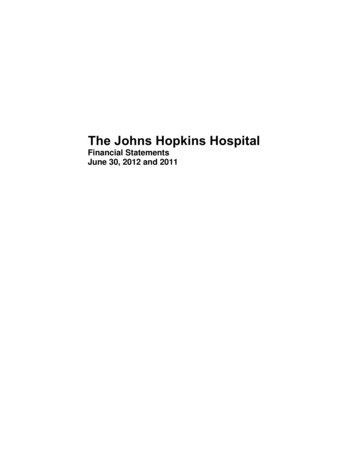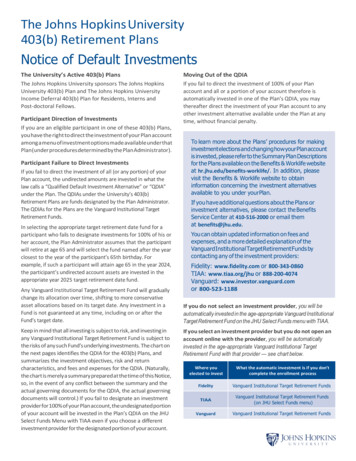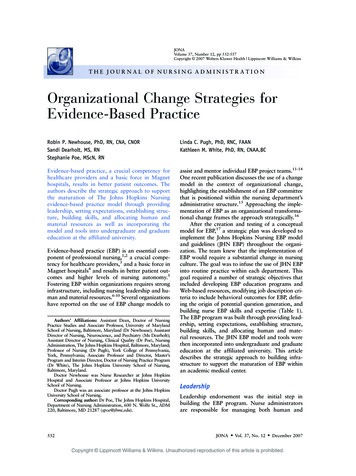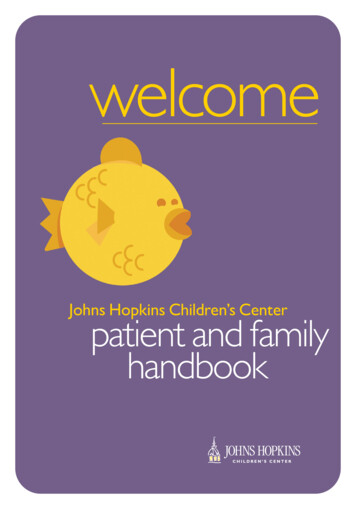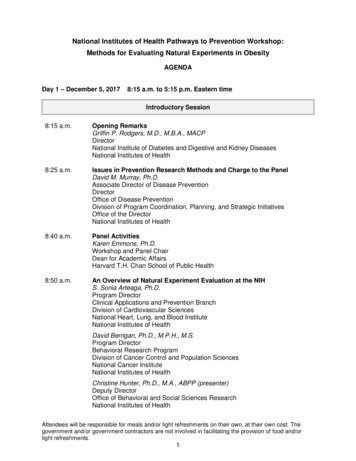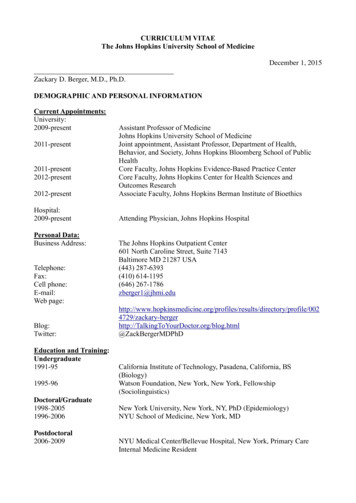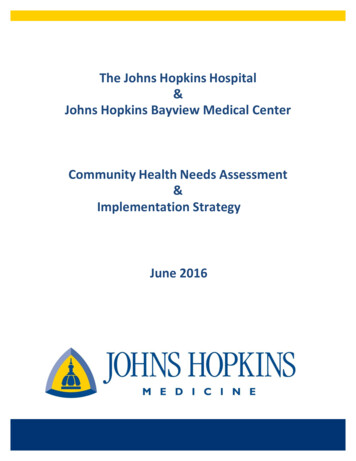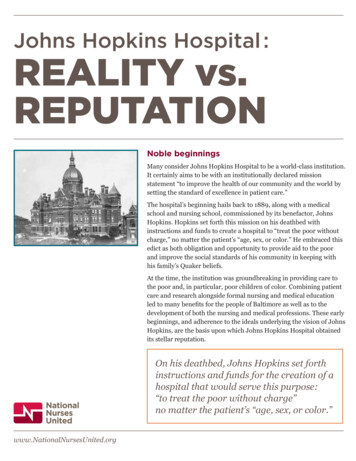
Transcription
Johns Hopkins Hospital :REALITY vs.REPUTATIONNoble beginningsMany consider Johns Hopkins Hospital to be a world-class institution.It certainly aims to be with an institutionally declared missionstatement “to improve the health of our community and the world bysetting the standard of excellence in patient care.”The hospital’s beginning hails back to 1889, along with a medicalschool and nursing school, commissioned by its benefactor, JohnsHopkins. Hopkins set forth this mission on his deathbed withinstructions and funds to create a hospital to “treat the poor withoutcharge,” no matter the patient’s “age, sex, or color.” He embraced thisedict as both obligation and opportunity to provide aid to the poorand improve the social standards of his community in keeping withhis family’s Quaker beliefs.At the time, the institution was groundbreaking in providing care tothe poor and, in particular, poor children of color. Combining patientcare and research alongside formal nursing and medical educationled to many benefits for the people of Baltimore as well as to thedevelopment of both the nursing and medical professions. These earlybeginnings, and adherence to the ideals underlying the vision of JohnsHopkins, are the basis upon which Johns Hopkins Hospital obtainedits stellar reputation.On his deathbed, Johns Hopkins set forthinstructions and funds for the creation of ahospital that would serve this purpose:“to treat the poor without charge”no matter the patient’s “age, sex, or color.”www.NationalNursesUnited.org
Reality falls short of reputationNurses are drawn to employment at Johns HopkinsHospital for the prestige and opportunity to practicenursing at one of the largest academic hospitals onthe East Coast. JHH provides nurses with the abilityto practice in a high-skilled setting providing care topatients with a variety of complex and uncommonconditions. Despite this, the reality of working at JohnsHopkins Hospital is far removed from the picturedescribed in marketing and recruitment materials.It is clear to nurses that the current executive leadersof Johns Hopkins Hospital have lost sight of the earlyvision of its founder. Nurses consistently experiencebarriers to providing the type of highly skilled andtechnical nursing care that all patients deserve —the kind of care that attracts patients to chooseJohns Hopkins.The challenges that nurses face in advocating for theirpatients and providing safe care are a result of theadministration’s conflicting values when prioritizingand allocating resources. These compromises made atthe expense of patients and care providers are dictatedby executives, far removed from the realities of patientcare, to save money and increase revenues.ARE NURSES SAFE ATJOHNS HOPKINS HOSPITAL?A survey conducted earlier this yearby Johns Hopkins nurses found:37% of Hopkins nurses reportthat they have experiencedworkplace violence in the past year.50.1% of nurses report thattheir concern was ignored ornothing happened after reporting.95% of Hopkins nurses repliedthat they feel at risk for injury atwork at least sometimes.Nurses document patient careconcerns in new reportDirect-care RNs who practice at Johns HopkinsHospital have written a report to bring attention topatient safety concerns that they and their patientsface every day. The report, “Foundations of Care:Upholding the Legacy of Hopkins’ Nurse Pioneers–Johns Hopkins Hospital Patient Care Report,”contains a unit-by-unit survey of hospital conditionsand is based entirely on the nurses’ first-handexperiences and observations.KEY FINDINGS» Patient safety is compromised by high turnoveramong registered nurses and lack of experiencednurses. RN turnover is creating a patient care crisis.» On many units, there are not enough RNs andsupport staff to meet individual patient care needs.» Necessary supplies, equipment, and protectivegear are often not available, creating delays in carethat pose a risk to the safety of patients and nurses.Supply shortages are widespread throughoutthe hospital and vary from specialty unit tospecialty unit.» Systemic failure to plan for increases in patientpopulation, acuity, and intensity creates conditionsthat leave patients vulnerable for missed care andcare left undone.» Poor working conditions: There is no system inplace for break relief, creating conditions that causefatigue, stress, and burnout.» Dysfunctional organizational culture that hascreated an atmosphere of fear, frustration,and futility.
Excerpts from the Johns Hopkins nurses’patient care report »»»» SHORT STAFFING/FAILURE TO PLANAdult Emergency Department Wait times (to receive care)are unsafe on most days, sometimes reaching up to 18 hours inthe waiting room Oncology patients, patients with chest pain,patients actively vomiting are just some of the patients left formany hours to wait. Nurses report that patients have had seizuresin the waiting room, loss of consciousness from bleeding, andcardiac arrests while waiting for a treatment bed in the main areaof the department.» SHODDY EQUIPMENT/INADEQUATE SUPPLIESThe gloves in the ComprehensiveTransplant Unit (Zayed 9W) are known torip. Gloves that are sturdy are especiallyimportant on the CTU because they carefor patients with different communicablediseases (e.g., HIV, hepatitis B and C) andpatients who receive medications withhazardous handling precautions (e.g. antirejection medicines), and it is unsafe fornurses to be exposed to the blood andother bodily fluids of these patients.The Surgical Intensive Care Unit(Weinberg 3A) reports that infusionpumps that are used to administer painmedication via the Patient ControlledAnalgesia (PCA) protocols are also inshort supply. These PCA pumps offera timely and safe delivery methodthat avoids overdose for administeringpotentially dangerous pain medicationsto patients needing frequent relief fromextreme pain, such as that caused bysickle-cell crisis.» TURNOVERThe Surgical Oncology Unit (Weinberg 4CD)is at a crisis point. Over the last year, almost50% of the nursing staff has left the floorwith most nurses leaving the hospital entirely.It is very difficult to retain nurses on thePediatric Intensive Care Unit (PICU). Itis common for an RN with one and ahalf years of experience to be the mostexperienced nurse on a shift. This collectivelack of experience is dangerous for patientsand places nurses in difficult situations inwhich they have to take assignments theyare not confident in performing.For more details consult the full report, “Foundationsof Care: Upholding the Legacy of Hopkins’ NursePioneers – Johns Hopkins Hospital Patient CareReport,” National Nurses Organizing Committee/JohnsHopkins RNs.
Johns Hopkins reaps more than it sows from huge tax exemptionsJohns Hopkins Hospital is a not-for-profit hospital, a designation that provides them with exemptions from a largenumber of federal, state, and local taxes. In exchange for these tax exemptions, surplus revenues from the not-forprofit hospital are supposed to benefit the community in which it is located.In a recent report, “Breaking the Promise of Patient Care: How Hopkins Hospital Management ShortchangesBaltimore and Puts Patients and the Community at Risk,” researchers found that the hospital receives far more inannual tax exemptions and public funding than they pay out in charity care and community benefits.KEY FINDINGS» Thanks to the state of Maryland’s unique rate support system that provides Johns Hopkins and other hospitalspublic funding, in fiscal year 2017 Johns Hopkins Hospital paid nothing in charity care from its own resources, andfar less from its own resources in community benefits than is commonly believed.» In fiscal year 2017 Johns Hopkins Hospital received 24,954,381 in charity care rate support (i.e. public funding)from the state of Maryland, and spent just 21,697,000 on charity care, leaving it with a surplus of 3,257,381.» Johns Hopkins Hospital also did not pay more for charity care than it received in rate support in three prior fiscalyears. When combined for the fiscal years 2013 through 2017, Johns Hopkins Hospital received 33,091,494 morein rate support than it paid for the charity care it reported.» The total loss to the public for fiscal year 2017 with respect to charity care, or the charity care provided from JohnsHopkins Hospital’s own resources minus the total value of the tax exemptions, is estimated to be 167,662,220.» Johns Hopkins track record in providing charity care when compared to other Maryland hospitals is abysmal.Between 2014 and 2017, Johns Hopkins Hospital was one of the lowest ranked hospitals, providing the least charitycare relative to rate support received. It ranked 49 out of 52 in 2017, 51 out of 52 in 2016, 53 out of 53 in 2015, and49 out of 52 in 2014.RNs organize to uphold legacy ofHopkins’ nurse pioneersJohns Hopkins nurses organizing today, to improvepatient care and hold the institution accountableto its mission, are inspired by Hopkins’ nursepioneers, Isabel Hampton Robb, Mary AdelaideNutting, and Lavinia Dock. These early foundersof nursing education and nursing practice at JohnsHopkins Hospital are recognized not only for theiracademic prowess and clinical skills, but also for theircommitment to social justice advocacy, which could beviewed as an extension of the profession’s core values.Together, this “extraordinary triumvirate of women”shared a commitment to the most challenging socialissues of their time, such as women’s suffrage, theabolition of slavery, and improving living conditionsfor the poor. A deep understanding of the socialdeterminants of health led them to be advocates farbeyond the walls of the nursing school and the hospital.—Mary Adelaide Nutting,Johns HopkinsSuperintendent of Nursing1894-1907It is a bad day for our schools, for ournurses, for physicians, and for sickpeople everywhere, when the firstquestion is always, “How little can wedo it for?” rather than “how well canwe do it?”
There is a tremendous need for charity care in Baltimore, especially inJohns Hopkins’ own neighborhood!Baltimore remains one of the poorest, large cities in theUnited States with an estimated poverty rate of 23.1percent for 2017. In fiscal year 2017, only 0.6 percent ofJohns Hopkins’ patients were uninsured despite the factthat Baltimore’s uninsured rate is 9 percent. Of 47,703inpatient admissions, just 284 patients were uninsured.1Johns Hopkins Hospital would have needed to see4,266 uninsured patients in FY 2017 for its uninsuredadmissions to match the current uninsured rate of thecity of Baltimore, something it fell far short of despite itslocation in East Baltimore.The zip code that surrounds Johns Hopkins Hospitalon three sides is 21205, a zip code with an estimatedpoverty rate of 38.6 percent, and one of the mostdistressed zip codes in America, ranked in the 93rdpercentile, with 100 percent being the most distressed(see figure 1).2The Old Town/Middle East neighborhood where JohnsHopkins Hospital is located has an infant mortality rateof 12.6 per 1,000 live births, 217 percent higher than theinfant mortality rate for the United States as a whole(5.8 per 1,000 live births).3 The neighborhood’s infantmortality rate is roughly equal to the rate for Malaysia,which is ranked 115 of 225 countries.4 Both China andMexico have lower infant mortality rates than the OldTown/Middle East neighborhood.5 Life expectancy inthe Old Town/ Middle East neighborhood is just 70.4years, 9.6 years lower than the 80 years of the UnitedStates as a whole, and equal to the life expectancy inTurkmenistan, ranked 159 out of 224 countries.6FIGURE 1. Zip codes in red are zip codes that are judged to be inthe 90th percentile for distress, or more distressed than 90 percentof other U.S. zip codes.This brochure contains information drawn from:“Breaking the Promise of Patient Care: How Hopkins Hospital Management Shortchanges Baltimore and PutsPatients and the Community at Risk.” Produced by National Nurses United and AFL-CIO. December 2018.Available at rature“Foundations of Care: Upholding the Legacy of Hopkins’ Nurse Pioneers – Johns Hopkins Hospital Patient CareReport.” Based entirely on first-hand experience and observations of direct-care RNs employed by Johns HopkinsHospital in Baltimore. National Nurses Organizing Committee/Johns Hopkins RNs. December 2018.Available at ratureEnd Notes1. Maryland Health Services Cost Review Commission, Community Benefits Program, Maryland Hospital Community Benefit Report: FY 2017 https://hscrc.maryland.gov/Pages/init cb.aspx, accessed 8/09/17.2. Economic Innovation Group, Distressed Communities Index (DCI), 2017, DCI Data for U.S. Zip Codes.3. Baltimore City Health Department, Baltimore City 2017 Neighborhood Health Profile, Old Town/Middle East, es/NHP%202017%20-%2041%20Oldtown-Middle%20East%20 (rev%206-9-17).pdf4. CIA, The World Factbook Country Comparison: Infant Mortality Rate, -factbook/rankorder/2091rank.html, accessed 8/21/18.5. Ibid.6. Baltimore City Health Department, Baltimore City 2017 Neighborhood Health Profile Old Town/Middle East, /NHP%202017%20-%2041%20Oldtown-Middle%20East%20 (rev%206-9-17).pdfCIA, The World Factbook Country Comparison: Life Expectancy at Birth, -factbook/rankorder/2102rank.html accessed8/21/18.
Sign the PetitionJoin the Johns Hopkins Nurses’ Call for Change!We, the undersigned nurses,patients, and community memberscall on Johns Hopkins Hospital’s management to liveup to the institution’s world-renowned reputation ofexcellence. We recognize that, historically and to thisday, JHH management has fallen short of this reputation.To begin to repair this harm, we call on JHHmanagement to:1. Declare and return the millions of unused and/ormisused dollars in rate support they receive underthe auspices of charity care to their patients and tothe East Baltimore community they have promisedto serve.2. Listen to and implement all of the patient carerecommendations put forth by nurses organizing toimprove care for JHH’s patients.3. Terminate their anti-union consultants and allow nursesto freely organize a union that can advocate on behalfof themselves, their patients, and our community.To read and sign the full petition ospital-petitionLearn more about Johns Hopkins nurses’ union organizing campaign by s-rns-speak-outFind us on Facebook at Hopkins Nurses United to learn of upcoming events!www.NationalNursesUnited.org
school and nursing school, commissioned by its benefactor, Johns . Hopkins. Hopkins set forth this mission on his deathbed with . » Johns Hopkins track record in providing charity care when compared to other Maryland hospitals is abysmal. Between 2014 and 2017, Johns Hopkins Hospital was one of the lowest ranked hospitals, providing the .

